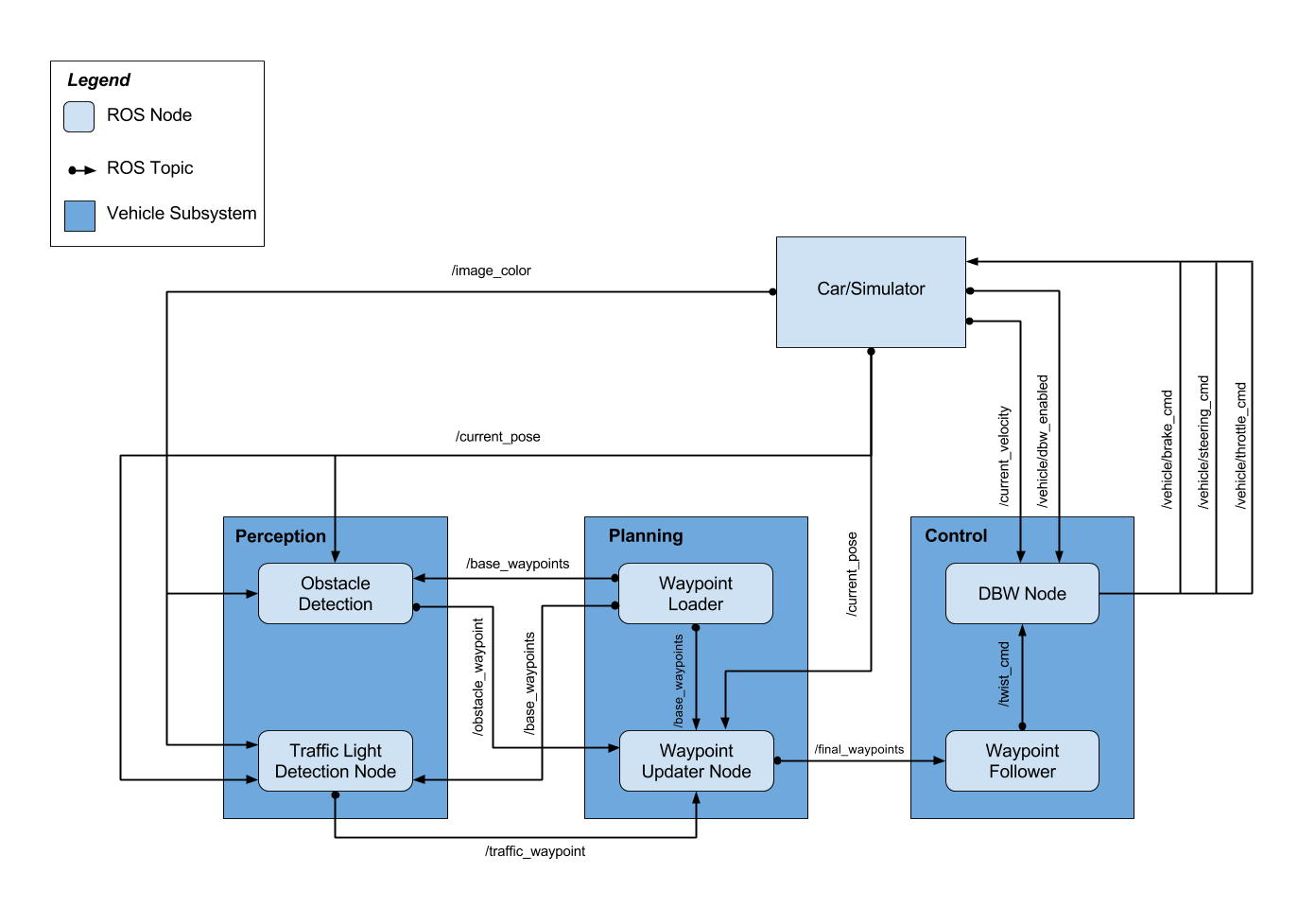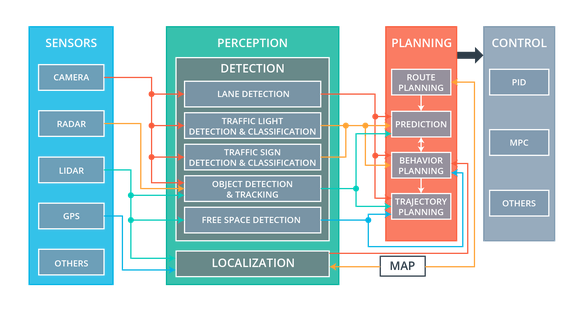Programming a Real Self-Driving Car
The goal of the project to navigate safely a self-driving car around a course. The car needs to keep the lane, stop in front of red lights and obstacles.
The Robot Operative System (ROS) framework was used in the project.
The general architecture of autonomous vehicles is described as below:
Demo
I used the provided ubuntu image from Udacity here to run my code, and I used my Ubuntu host machine to run the simulator.
The full demo is at https://youtu.be/M0uoezBJdqM
Implementation details
The System Architecture Diagram

In this project, I have focused on 3 ROS nodes:
1. Waypoint Updater
The code of this node is in ./ros/src/waypoint_updater/waypoint_updater.py
- The
waypoint_updaternode subscribes to the/base_waypointstopic, which publishes a list of all waypoints for the track. - The
waypoint_updaternode finds for the closest waypoint in front of the car, the the node publishes a list of the nextLOOKAHEAD_WPS=200waypoints to the/final_waypointstopic (x, y coordinates, and target linear velocity of each waypoint). - The
waypoint_followernode subscribes to the/final_waypointstopic to determine the target linear and angular velocity for the car. - The
waypoint_updaternode subscribes to the/traffic_waypointtopic that includes the nearest waypoint to the stop position (in front of a red light). The car will adjust its velocity to appropriate with the traffic light signals.
2. DBW_node (drive-by-wire node)
The code of this node is in ./ros/src/twist_controller/dbw_node.py.
-
The
dbw_nodenode subscribes to the/current_velocityand/twist_cmdtopics, and use various controllers to provide appropriate throttle, brake, and steering commands. -
The
dbw_nodenode publishes these topics:vehicle/steering_cmdvehicle/throttle_cmdvehicle/brake_cmd
3. Traffic Light Detector
The code of this part is in ./ros/src/tl_detector/tl_detector.py.
-
The traffic light detection node
(tl_detector.py)subscribes to 4 topics:/base_waypointsprovides the complete list of waypoints for the course./current_posecan be used to determine the vehicle's location./image_colorwhich provides an image stream from the car's camera. These images are used to determine the color of upcoming traffic lights./vehicle/traffic_lightsprovides the (x, y, z) coordinates of all traffic lights.
-
The node publishes the index of the waypoint for nearest upcoming red light's stop line to a single topic:
/traffic_waypoint
Installation instructions
More information https://github.com/udacity/CarND-Capstone
1. Native Installation
-
Be sure that your workstation is running Ubuntu 16.04 Xenial Xerus or Ubuntu 14.04 Trusty Tahir. Ubuntu downloads can be found here.
-
If using a Virtual Machine to install Ubuntu, use the following configuration as minimum:
- 2 CPU
- 2 GB system memory
- 25 GB of free hard drive space
The Udacity provided virtual machine has ROS and Dataspeed DBW already installed, so you can skip the next two steps if you are using this.
-
Follow these instructions to install ROS
- ROS Kinetic if you have Ubuntu 16.04.
- ROS Indigo if you have Ubuntu 14.04.
-
- Use this option to install the SDK on a workstation that already has ROS installed: One Line SDK Install (binary)
-
Download the Udacity Simulator.
2. Docker Installation
Build the docker container
docker build . -t capstoneRun the docker file
docker run -p 4567:4567 -v $PWD:/capstone -v /tmp/log:/root/.ros/ --rm -it capstone3. The pre-built image
Download the provided ubuntu image from Udacity here to run the code, use a Ubuntu host machine to run the simulator.
Config Network: Port Forwarding
Read instruction here
Download the simulator
The simulator could be downloaded from here
Usage
- Clone the project repository
git clone https://github.com/maudzung/Self-Driving-Car-09-Programing-A-Real-Car.git- Install python dependencies
cd Self-Driving-Car-09-Programing-A-Real-Car
pip install -r requirements.txtif having error with scipy, execute:
sudo apt-get install python-scipy- Make and run styx
Add execute mode to *py
chmod -R +x ./ros/srcInitialize the catkin workspace:
cd ros/src
rm CMakeLists.txt
catkin_init_workspaceBuild and execute:
cd ros
catkin_make
source devel/setup.sh
roslaunch launch/styx.launch- Run the simulator
Real world testing
- Download training bag that was recorded on the Udacity self-driving car.
wget https://s3-us-west-1.amazonaws.com/udacity-selfdrivingcar/traffic_light_bag_file.zip - Unzip the file
unzip traffic_light_bag_file.zip- Play the bag file
rosbag play -l traffic_light_bag_file/traffic_light_training.bag- Launch your project in site mode
cd Self-Driving-Car-09-Programing-A-Real-Car/ros
roslaunch launch/site.launch- Confirm that traffic light detection works on real life images
Other library/driver information
Outside of requirements.txt, here is information on other driver/library versions used in the simulator and Carla:
Specific to these libraries, the simulator grader and Carla use the following:
| Simulator | Carla | |
|---|---|---|
| Nvidia driver | 384.130 | 384.130 |
| CUDA | 8.0.61 | 8.0.61 |
| cuDNN | 6.0.21 | 6.0.21 |
| TensorRT | N/A | N/A |
| OpenCV | 3.2.0-dev | 2.4.8 |
| OpenMP | N/A | N/A |

